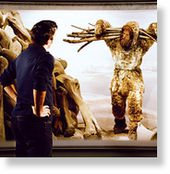
© H Bond (STScI), R Ciardullo (PSU), WFPC2, HST/ NASAWhite dwarfs - small, dense, dying stars - may be hiding a dark secret.
The brightness of white dwarfs may point towards the existence of exotic dark matter particles.
Jordi Isern of the Institute of Space Sciences in Bellaterra, Spain, and colleagues modelled what would happen if white dwarfs - small, dense, dying stars - were emitting axions. These hypothetical particles are a candidate for dark matter, which makes up most of the universe.
Many reports about earthquakes have suggested that the escape of gases was a major effect, both before, during and after the quakes.
The modern theory has it that some subterranean forces, of unknown origin, gradually build up strains in the crustal rocks, up to the breaking point. The earthquake is then supposed to denote the moment of fracture of that rock.
Many features of earthquakes seem to have no explanation in this theory.
Why would there be many occasions of multiple large quakes over a period of a few days to months? Would the rock not break in all the locations in which it is already stressed to near breaking point, at the time it is violently shaken? Why would the ground shake sometimes for periods longer than a minute? Why would quakes cause tsunamis, the massive ocean waves? A brief tremor, however fierce, would not have such an effect. Perhaps the modern earthquake research had omitted the consideration of effects due to the sudden movements and the rapid large changes of volume that gases may cause. We shall therefore discuss the huge eruptions that have brought up diamonds, and we might well ask whether there may not be smaller ones much more frequently. Are they the initiating events for earthquakes as well as for volcanic eruptions?
Eye-witness accounts strongly suggest that gas eruptions are the initiating events, but in modern times not much attention is paid to such information, because it is considered too uncertain. Instead the effects that can be measured with accuracy, such as a gradual increase of the strains in rocks and the relation of this to earthquakes, has now become the main subject of research in this field in the US. The overriding importance of this research would lie in finding a method for the prediction of earthquakes, but no such method has so far been found.
A long-standing astronomical mystery is "What type of star system will explode as a supernova?" It turns out that this question can be resolved by looking at century-old photographs. On studying archival data back to 1890, the result is that recurrent novae are the precursors to supernovae. With this knowledge, astronomical theorists can now perform the calculations to make subtle corrections that allow for the promise of precision-cosmology by upcoming programs involving supernovae. The lesson here is that old astronomical archives are valuable resources that can be used to produce unique and front-line science, in ways that no combination of modern telescopes can provide.
Professor Bradley E. Schaefer of Louisiana State University, Baton Rouge, discusses this finding today at a press conference during the 213th meeting of the American Astronomical Society (AAS) in Long Beach, California.
Egypt's antiquities chief unveiled Sunday a bronze statue of what he described as an ancient Mesopotamian goddess that had been looted from Iraq.
Zahi Hawass said an Egyptian man working in Jordan was caught at Nuweiba port trying to smuggle the statue into the country.
In the course of the ceremony, Hawass sliced through the plastic bubble wrap covering the 10 centimeter tall statue and handed it over to the Iraqi Charge d'Affaires, Abdel Hadi Ahmed.
"When the invasion of Iraq began in 2003, we wrote to the British and American governments asking them to protect Iraq's heritage and museums," said Hawass. "But that didn't happen."

© Grant Delin
* Among Charles Darwin's lasting legacies is our knowledge that the human mind evolved by some adaptive process.
* A major, widely discussed branch of evolutionary psychology - Pop EP - holds that the human brain has many specialized mechanisms that evolved to solve the adaptive problems of our hunter-gatherer ancestors.
* The author and several other scholars suggest that some assumptions of Pop EP are flawed: that we can know the psychology of our Stone Age ancestors, that we can thereby figure out how distinctively human traits evolved, that our minds have not evolved much since the Stone Age, and that standard psychological questionnaires yield clear evidence of the adaptations.
IS it a car? Is it a plane? Actually it's both. The first flying automobile, equally at home in the sky or on the road, is scheduled to take to the air next month.
If it survives its first test flight, the Terrafugia Transition, which can transform itself from a two-seater road car to a plane in 15 seconds, is expected to land in showrooms in about 18 months' time.
Its manufacturer says it is easy to keep and run since it uses normal unleaded fuel and will fit into a garage.
Julie Steenhuysen
ReutersSat, 10 Jan 2009 22:44 UTC
Chicago- U.S. scientists have found a way to levitate the very smallest objects using the strange forces of quantum mechanics, and said on Wednesday they might use it to help make tiny nanotechnology machines.
They said they had detected and measured a force that comes into play at the molecular level using certain combinations of molecules that repel one another.
The repulsion can be used to hold molecules aloft, in essence levitating them, creating virtually friction-free parts for tiny devices, the researchers said.
Jonathan Wright
ReutersSat, 10 Jan 2009 22:41 UTC
Cairo- Egyptian archaeologists have found the remains of a mummy thought to be that of Queen Seshestet, the mother of a pharaoh who ruled Egypt in the 24th century BC, the government said on Thursday.
After five hours spent lifting the lid of a sarcophagus in a pyramid discovered south of Cairo last year, they found a skull, legs, pelvis, other body parts wrapped in linen, and ancient pottery, the government's antiquities department said.
They also found gold wrappings which would have been put on the fingers of the mummified person. Grave robbers ransacked the burial chamber in ancient times and stole the other objects.
Bed bugs, once nearly eradicated in the built environment, have made a big comeback recently, especially in urban centers such as New York City. In the first study to explain the failure to control certain bed bug populations, toxicologists at the University of Massachusetts Amherst and Korea's Seoul National University show that some of these nocturnal blood suckers have developed resistance to pyrethroid insecticides, in particular deltamethrin, that attack their nervous systems.
The study by senior researcher John Clark and colleagues in the current issue of the Journal of Medical Entomology reveals that these pests have evolved to outsmart the latest generation of chemicals used to control them since DDT was banned. In providing this first look at a mechanism, the researchers summarize that diagnostic tools to detect the relevant mutation in bed bug populations have been "urgently needed for effective control and resistance management."
In popular legend, Lucrezia Borgia, Duchess of Ferrara (1480- 1519), stands falsely accused of poisoning her second husband. Victor Hugo portrayed her in thinly veiled fiction as a tragic femme fatale. Buffalo Bill named his gun after her.
But new research by USC historian Diane Yvonne Ghirardo reveals that the only sister of Machiavelli's Prince was less interested in political intrigue than in running a business, undertaking massive land development projects that "stand alone in the panorama of early sixteenth-century projects, not only those initiated by women," Ghirardo says.
Forced by an economic downturn to cut expenses and become an entrepreneur, the illegitimate daughter of Pope Alexander VI would control between 30,000 and 50,000 acres in northern Italy within six years.
"This is a classic case of seeing only what you're looking for and not getting the whole picture," Ghirardo says of the centuries-old mystery surrounding how Lucrezia accumulated her vast personal wealth. Ghirardo notes that historians have long dismissed Lucrezia as stupida because no record exists of her collecting art or antiquities.
"The information was there in the archives, but because she was a woman, scholars only looked at transactions for clothes, for jewelry, or for works of art. Nobody looked at the other entries in the account registers," says Ghirardo of the research project that took her more than seven years.




